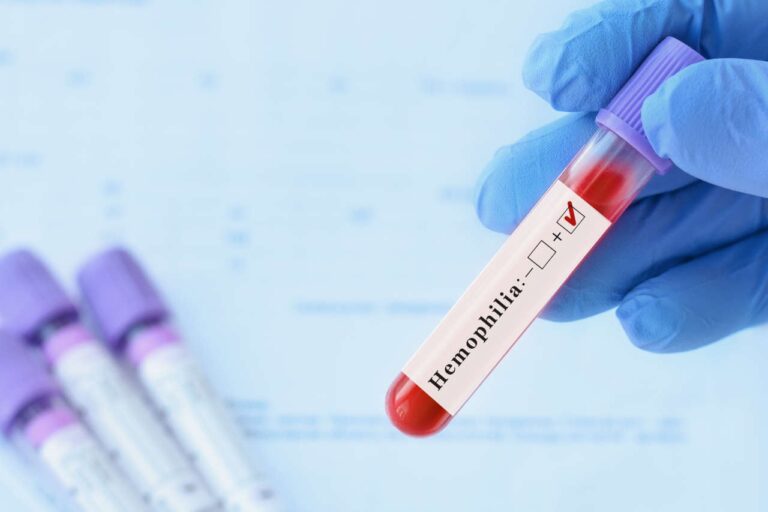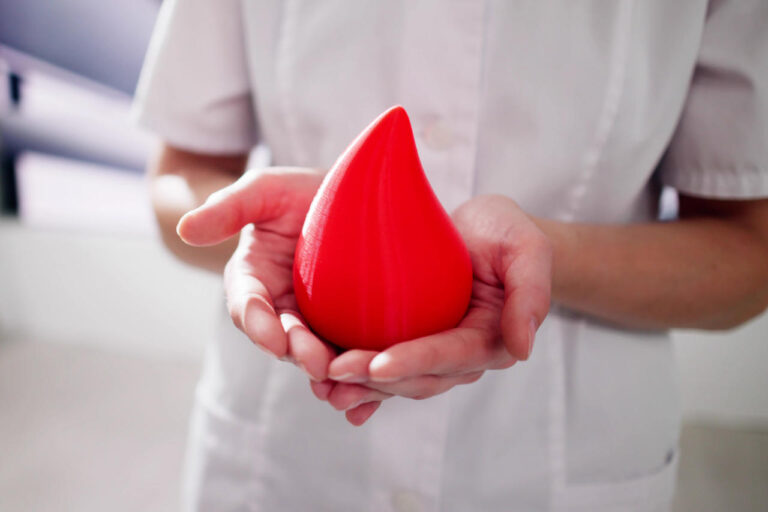
Hemophilia C is a rare blood disorder in which a clotting factor called factor XI is missing, low, or doesn’t work as it should. Because clotting factors are essential for clotting, having hemophilia C can put you at a higher risk of prolonged bleeding, especially after surgery, dental procedures, or injury.
Speak to a Specialist
About Copay AssistanceOther names for this condition are:
- Plasma thromboplastin antecedent deficiency
- PTA deficiency
- Rosenthal syndrome
- Factor XI deficiency
In this article, we will cover the most frequently asked questions about this blood disorder.
1. How Common Is Hemophilia C?
Hemophilia C is a rare blood disorder. It affects about 1 in 100,000 people, according to the National Bleeding Disorders Foundation [1].
Hemophilia C can affect people of any age, sex, race, or ethnicity. Nonetheless, a higher prevalence — 1 in 450 individuals — has been reported in people of Ashkenazi Jewish descent [2].
2. How Is Hemophilia C Inherited?
Changes (mutations) in the gene that encodes clotting factor XI cause hemophilia C. Typically, these mutations pass from the parents to the child in an autosomal recessive pattern. This means an affected person gets the mutated gene from both parents.
The parents who carry one copy of the gene have partial factor XI deficiency. So they’re unlikely to have severe signs and symptoms of the condition.
Sometimes, a person may inherit the mutated gene in an autosomal dominant pattern. This means they may get hemophilia C even if only one parent has the condition.
3. What Is Acquired Hemophilia C?
Acquired factor XI deficiency is when a person gets the condition later in life. Unlike the inherited form, it doesn’t run in families.
The most common cause is liver disorder, which affects the production of factor XI. You may develop acquired hemophilia C if you’ve received a liver transplant from a factor XI-deficient donor.
In some cases, your immune system mistakenly produces proteins (autoantibodies) that attack factor XI, leading to factor XI deficiency.
4. What Are the Symptoms?

Not all people with a factor XI deficiency experience symptoms. Unlike other forms of hemophilia, lower levels of factor XI in the bloodstream don’t always result in more severe symptoms.
Symptoms can include:
- Frequent nosebleeds
- Easy bruising
- Blood in urine
- Unusual bleeding after dental procedures, surgery, or trauma
- Heavy menstrual bleeding
- Bleeding after childbirth
People with this condition rarely get joint and muscle bleeds.
Also Read: Hemophilia and Joint Health: How To Prevent and Treat Joint Damage
Get Financial Assistance
5. What Is the Most Common Treatment for This Condition?
Treatment may not always be necessary, especially if bleeding isn’t problematic. However, those with mild symptoms may need to restrict activities that increase the risk of injury, such as contact sports.
You’ll usually need treatment before undergoing surgery or other procedures. In severe cases, you’ll need fresh frozen plasma (FFP), which is a clotting factor-rich blood derivative obtained from donors.
Other treatment options can include:
- Antifibrinolytics, such as aminocaproic acid and tranexamic acid, to treat bleeding in the mouth and menstrual bleeding.
- Medications to prevent the breakdown of replacement clotting factors.
- Birth control pills for heavy menstrual bleeding
6. How Is Hemophilia C Treated During Pregnancy?
There are no evidence-based guidelines for hemophilia C treatment during pregnancy. The standard treatment is administering fresh frozen plasma at the time of delivery.
Treatment during pregnancy is anticipatory and requires a multidisciplinary care team.
The authors of a 2020 review recommend [3]:
- Early pregnancy consultation with a hematologist and perinatologist
- Third-trimester consultation with an anesthesiologist
- Measuring third-trimester factor XI level
- Delivery at a tertiary care
- Prophylactic antifibrinolytic at the time of delivery
- Avoiding invasive procedures during delivery
7. What Is the Difference Between Hemophilia A and C?
Both are inherited blood disorders; however, there are differences, as shown below:
| Hemophilia A | Hemophilia C |
| Caused by Factor VIII deficiency | Caused by Factor XI deficiency |
| An X-linked disorder that mainly affects males | An autosomal recessive disorder that equally affects males and females |
| Joint bleeds are a hallmark of hemophilia A | Joint bleeds are less frequent |
| Common (affects nearly 1 in 5,000 newborn males) | Rare (affects 1 in 100,000 people) |
| A more severe form of hemophilia | Less severe than hemophilia A |
REFERENCES:
- Other factor deficiencies | NBDF. (n.d.). National Bleeding Disorders Foundation. https://www.bleeding.org/bleeding-disorders-a-z/types/other-factor-deficiencies
- Factor XI deficiency: MedlinePlus Genetics. (n.d.). https://medlineplus.gov/genetics/condition/factor-xi-deficiency/#frequency
- Wheeler, Allison P et al. “The clinical management of factor XI deficiency in pregnant women.” Expert review of hematology vol. 13,7 (2020): 719-729. doi:10.1080/17474086.2020.1772745












